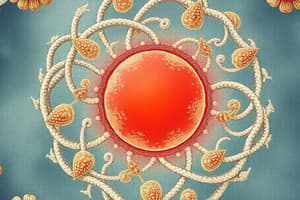Podcast
Questions and Answers
What are membranous organelles?
What are membranous organelles?
Permanent structures in nucleated cells that contain enzymes and are enclosed in membranes.
Which of the following are examples of membranous organelles? (Select all that apply)
Which of the following are examples of membranous organelles? (Select all that apply)
- Mitochondria (correct)
- Golgi complex (correct)
- Cell membrane (correct)
- Cytoplasm
What are intrinsic proteins?
What are intrinsic proteins?
Proteins made of small or large protein molecules firmly embedded in the lipid bilayer.
Extrinsic proteins can be easily removed from the cell membrane without disrupting the lipid bilayer.
Extrinsic proteins can be easily removed from the cell membrane without disrupting the lipid bilayer.
What is the cell coat (glycocalyx)?
What is the cell coat (glycocalyx)?
What does the basal surface of epithelial cells contain?
What does the basal surface of epithelial cells contain?
What are the main classes of lipids in the cell membrane?
What are the main classes of lipids in the cell membrane?
The protruding structures on the apical surface of the epithelium that increase absorptive surface area are called __________.
The protruding structures on the apical surface of the epithelium that increase absorptive surface area are called __________.
Myelin sheath surrounds nerve fibers and conducts nerve impulses.
Myelin sheath surrounds nerve fibers and conducts nerve impulses.
What happens during simple transport (diffusion) across the cell membrane?
What happens during simple transport (diffusion) across the cell membrane?
What role do cilia play on the surface of respiratory tract epithelium?
What role do cilia play on the surface of respiratory tract epithelium?
Flashcards are hidden until you start studying
Study Notes
Membranous Organelles
- Permanent structures found in nucleated cells
- Contain enzymes
- Enclosed within membranes
- Participate in cellular metabolism
- Examples: cell membrane, mitochondria, Golgi complex, lysosomes, peroxisomes, endoplasmic reticulum (rough and smooth), and coated vesicles
Cell Membrane Proteins
- Arranged as extrinsic or intrinsic proteins
Extrinsic Proteins (Peripheral Proteins)
- Loosely attached to the cell membrane's surface
- Easily removed without disrupting the lipid bilayer
Intrinsic Proteins (Integral Proteins)
- Firmly embedded in the lipid bilayer
- Some extend across the entire width of the membrane, protruding from both surfaces
- Transmembrane proteins are involved in transporting molecules in and out of the cell
- Can be "one-pass" or "multi-pass" proteins
- Have hydrophilic regions at outer and inner membrane surfaces
- Have hydrophobic regions in the center of the lipid bilayer
The Cell Coat (Glycocalyx)
- Layer of glycoprotein or glycolipid on the cell membrane's external surface
- Functions: immunological specificity, contains blood group antigens, receptor sites, holds cells together, forms part of basement membrane for epithelial tissues, protective mechanical barrier
Cell Surface Specializations
Lateral Surfaces
- Junctional complexes and interdigitations interlock adjacent epithelial cells
Basal Surfaces
- Flagella propel sperm cells
The Cell Membrane (Plasmalemma)
- Site: surrounds the cell
- Structure:
- Thin and difficult to see by light microscopy
- Appears dark brown when stained with silver
- Electron micrograph shows two dark layers separated by a light layer (trilaminar membrane)
- Chemical composition: lipids, proteins, and carbohydrates
The Lipid Component
- Major classes: phospholipids, glycolipids, and cholesterol
- Phospholipids form a double layer
- Polar (hydrophilic) heads directed outwards, appear dark in electron microscopy
- Non-polar (hydrophobic) tails directed inwards, appear light in electron microscopy
Apical Surface
- Microvilli are finger-like projections that increase absorptive surface area in epithelia
- Cilia move particles or fluids in one direction on respiratory tract epithelium
Around the Surface
- Myelin sheath surrounds nerve fibers to insulate nerve impulses
Cell Membrane Functions
- Simple transport (diffusion) allows gases and water to pass through the membrane by diffusion
- Active transport requires energy for large molecules like sugar to enter the cell
Studying That Suits You
Use AI to generate personalized quizzes and flashcards to suit your learning preferences.




